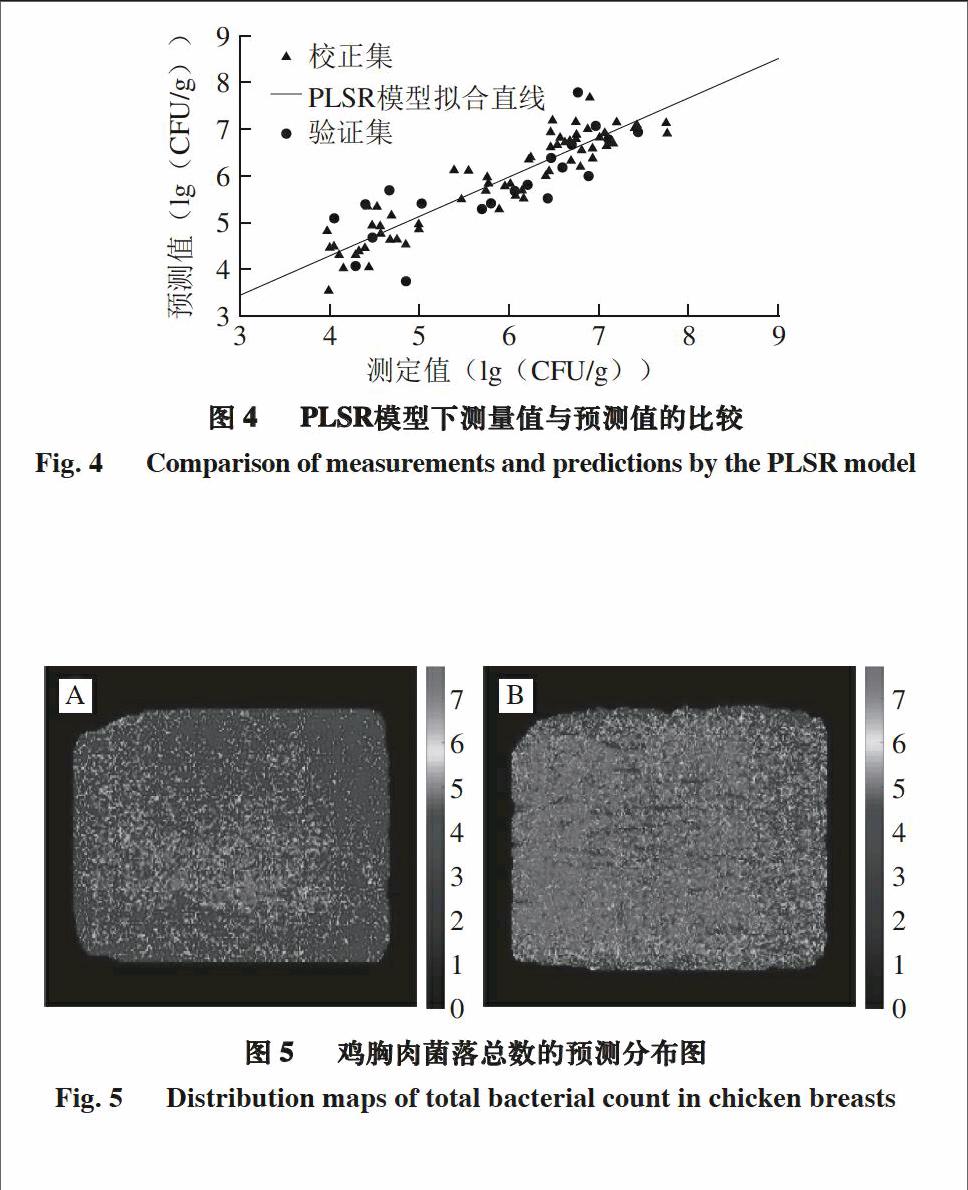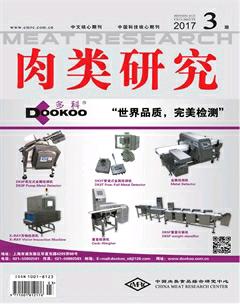基于高光谱成像技术的鸡肉菌落总数快速无损检测
李文采++刘飞++田寒友++邹昊++王辉++张振琪



摘 要:以市售新鲜冷藏(4 ℃)鸡胸肉为研究对象,采集鸡胸肉表面的高光谱(400~1 100 nm)图像信息,采用偏最小二乘回归(partial least square regression,PLSR)建立菌落总数预测模型,采用不同预处理方法提高模型的预测准确性和稳健性,实现快速无损检测生鲜鸡胸菌落总数的目的。结果表明:标准变量变换(standard normalized variate,SNV)预处理后,模型性能最佳。模型的校正标准差(standard error of calibration,sEC)和验证标准差(standard error of prediction,sEP)分别为0.40和0.57,sEP/sEC为1.08,校正集相关系数(correlation coefficient of prediction,RC)和验证集相关系数(correlation coefficient of prediction,RP)分别为0.93和0.86;且应用最佳模型可有效预测样品菌落总数的分布地图。
关键词:鸡肉;菌落总数;高光谱成像;图像预处理;偏最小二乘法(PLSR);无损检测
Rapid Non-Destructive Detection of Total Bacterial Count in Chicken Using Hyperspectral Imaging
LI Wencai1, LIU Fei1, TIAN Hanyou1, ZOU Hao1, WANG Hui1, ZHANG Zhenqi1, ZHENG Xiaochun2, LI Yongyu2,
LI Jiapeng1, QIAO Xiaoling1,*
(1. Beijing Key Laboratory of Meat Processing Technology, China Meat Research Center, Beijing 100068, China;
2.College of Engineering, China Agricultural University, Beijing 100083, China)
Abstract: In order to develop a rapid and non-destructive method to predict total bacterial count in chicken breasts by using hyperspectral imaging technology, 83 chicken breast samples refrigerated at 4 ℃ were collected from local supermarket and 63 of these were used as calibration samples. The hyperspectral scattering image of each sample was collected by using hyperspectral imaging system in the wavelength range of 400?1 100 nm. Various algorithm combinations were used to preprocess the hyperspectral information of the samples to enhance the performance of the model developed by using partial least square regression (PLSR) algorithm. Based on the predictive accuracy and stability of the model, the efficiency of different algorithm combinations for spectral preprocessing were evaluated and discussed. The results showed that the optimal model performance was achieved by preprocessing of the hyperspectral information with standard normalized variate. The standard error of calibration (sEC) and standard error of prediction (SEP) of the model were 0.40 and 0.57, respectively. The correlation coefficients of calibration (RC) and prediction (RP) were 0.93 and 0.86, respectively. The optimal model allowed effective prediction of distribution maps of total bacterial count in chicken breasts.
Key words: chicken; total bacterial count; hyperspectral imaging; image processing; partial least square regression (PLSR); non-destructive detection
DOI:10.7506/rlyj1001-8123-201703007
中图分类号:O657.33 文獻标志码:A 文章编号:1001-8123(2017)03-0035-05
摘 要:以市售新鲜冷藏(4 ℃)鸡胸肉为研究对象,采集鸡胸肉表面的高光谱(400~1 100 nm)图像信息,采用偏最小二乘回归(partial least square regression,PLSR)建立菌落总数预测模型,采用不同预处理方法提高模型的预测准确性和稳健性,实现快速无损检测生鲜鸡胸菌落总数的目的。结果表明:标准变量变换(standard normalized variate,SNV)预处理后,模型性能最佳。模型的校正标准差(standard error of calibration,sEC)和验证标准差(standard error of prediction,sEP)分别为0.40和0.57,sEP/sEC为1.08,校正集相关系数(correlation coefficient of prediction,RC)和验证集相关系数(correlation coefficient of prediction,RP)分别为0.93和0.86;且应用最佳模型可有效预测样品菌落总数的分布地图。
关键词:鸡肉;菌落总数;高光谱成像;图像预处理;偏最小二乘法(PLSR);无损检测
Rapid Non-Destructive Detection of Total Bacterial Count in Chicken Using Hyperspectral Imaging
LI Wencai1, LIU Fei1, TIAN Hanyou1, ZOU Hao1, WANG Hui1, ZHANG Zhenqi1, ZHENG Xiaochun2, LI Yongyu2,
LI Jiapeng1, QIAO Xiaoling1,*
(1. Beijing Key Laboratory of Meat Processing Technology, China Meat Research Center, Beijing 100068, China;
2.College of Engineering, China Agricultural University, Beijing 100083, China)
Abstract: In order to develop a rapid and non-destructive method to predict total bacterial count in chicken breasts by using hyperspectral imaging technology, 83 chicken breast samples refrigerated at 4 ℃ were collected from local supermarket and 63 of these were used as calibration samples. The hyperspectral scattering image of each sample was collected by using hyperspectral imaging system in the wavelength range of 400?1 100 nm. Various algorithm combinations were used to preprocess the hyperspectral information of the samples to enhance the performance of the model developed by using partial least square regression (PLSR) algorithm. Based on the predictive accuracy and stability of the model, the efficiency of different algorithm combinations for spectral preprocessing were evaluated and discussed. The results showed that the optimal model performance was achieved by preprocessing of the hyperspectral information with standard normalized variate. The standard error of calibration (sEC) and standard error of prediction (SEP) of the model were 0.40 and 0.57, respectively. The correlation coefficients of calibration (RC) and prediction (RP) were 0.93 and 0.86, respectively. The optimal model allowed effective prediction of distribution maps of total bacterial count in chicken breasts.
Key words: chicken; total bacterial count; hyperspectral imaging; image processing; partial least square regression (PLSR); non-destructive detection
DOI:10.7506/rlyj1001-8123-201703007
中图分类号:O657.33 文獻标志码:A 文章编号:1001-8123(2017)03-0035-05
卤钨灯直流点光源(Oriel Instruments) 美国
Stratford公司;CD33-120N-422位置传感器 日本Optex公司;Intel core i3-3240计算机 联想有限公司。
该仪器采用的光谱范围为400~1 100 nm,可以采集鸡肉样品表面的散射光谱,其光谱分辨率为2.8 nm。
1.3 方法
1.3.1 样品制备
实验时从冰箱随机取样,切成厚度大约为1 cm,质量大约为10 g的鸡肉块,每24 h测定1 次,每次测定3 个样品。
1.3.2 样品高光谱信息的采集
每隔24 h从4 ℃冰箱中随机取出鸡胸肉样品,利用实验室构建的高光谱成像系统,采集400~1 100 nm波长范围内的鸡肉样品表面散射光谱,曝光时间为80 ms。由相机软件(Camera control Kit V2.19)完成图像采集过程,为确保样本的一致性,扫描过程中所采集样本的扫描线需与鸡肉样本纤维方向平行,每扫描4 次,自动平均得到一条扫描线。实验过程中对每个样本表面进行全扫描,得到160 个扫描图像。
1.3.3 样品菌落总数的测定
对高光谱图像进行采集后,立即对鸡胸肉样品表面菌落总数进行检测。本实验参考GB 4789.2—2010[24]中的10 倍梯度稀释法进行操作,选取合适的稀释梯度,每个稀释梯度倒3 块平板,37 ℃条件下培养48 h后计数,取菌落总数的对数值作为分析数据,单位为lg(CFU/g)。
1.3.4 数据分析
高光谱图像信息采集后,采用MATLAB2015b(美国Mathworks公司)对数据进行分析。依次提取冷却鸡肉样本高光谱图像感兴趣区域(range of interest,ROI),计算其平均散射光谱值,将其作为鸡肉样本的原始光谱值。对光谱图像特征进行分析后,应用PLSR对光谱数据和菌落总数测定值进行关联,建立鸡胸肉菌落总数预测模型。
1.3.5 模型预处理方法的筛选
选择的预处理方法包括:归一化方法(normalization method,NM)、Savitzky-Golay求导(Savitzky-Golay derivative,SGD)、标准变量变换(standard normalized variate,SNV)、附加散射校正(multiplication scatter correction,MSC)。
对样品高光谱信息进行不同预处理,去除无关干扰信息、降低随机噪声和强化谱带特征,采用PLSR统计方法建模,综合校正标准误差(standard error of calibration,sEC)、验证标准误差(standard error of prediction,sEP)、验证标准差和校正标准误差的比值(sEP/sEC)和差值(sEP-sEC)对模型性能进行评价[25],筛选出最佳预处理方法。
1.3.6 模型评价原则
sEP 代表高光谱分析的总误差,其中包括可靠性偏差、稳健性偏差和信息处理过程产生的误差,因此可以直接用于评价模型的预测准确性。sEC代表模型在建模样品范围内的分析误差,不包括稳健性偏差,因此sEP-sEC
应大于0。美国谷物化学组织的近红外分析标准中将
sEP/sEC作为评价模型稳健性的参数,规定sEP/sEC应小于1.2,其值大于1.2时则表示模型的稳健性不够[20]。
因此,在筛选性能最佳的模型时,首先模型应同时满足sEP/sEC<1.2或sEP-sEC>0,然后在剩余的模型中選取sEP最小的模型,此模型不仅稳健且预测准确性较好,这个模型所对应的算法或算法组合即为最佳预处理方法。
1.3.7 菌落总数分布地图
用高光谱成像技术预测菌落总数,不仅可以提供光谱信息还可以提供菌落总数的空间分布[26-29]。高光谱图像中每个像素点对应一个光谱,因此在每个像素点上可计算出样品菌落总数的预测值,从而构成分布地图。本实验中,利用PLSR模型预测光谱图像中每一个像素点对应的菌落总数,最终构成菌落总数预测值的分布地图。
2 结果与分析
2.1 样品菌落总数化学测量值的测定结果
本实验所用的83 个鸡胸肉样品的菌落总数化学测量值的统计结果如表1所示,涵盖新鲜鸡肉菌落总数(约3.97(lg(CFU/g)))至腐败鸡肉菌落总数(约7.75(lg(CFU/g))),GB 16869—2005[3]对鲜禽产品中菌落总数含量所允许的最大值为6(lg(CFU/g)),3.97~7.75(lg(CFU/g))的范围说明本实验选用的样品具有较强的代表性。从总样品集中选取菌落总数化学测量值分布均匀的样品63 个作为校正集,用于模型的建立;剩余的20 个样品作为验证集,用于验证模型的预测准确性和稳健性,统计结果见表1。
2.2 鸡肉高光谱图像感兴趣区域的确定
利用Matlab2015b分析软件从高光谱图像中提取ROI。图1所示为不同扫描位置的光谱图像,图2所示鸡肉样品不同扫描位置处的光谱曲线,距离扫描线中心0、10、15、20 nm位置处整个波长范围内的散射光谱。
由图2可知,在波长方向上,低于470 nm和高于920 nm位置处形成较大噪音影响,信号较弱;在空间方向上,扫描线中心位置的散射强度最大,距离扫描线中心位置越远,散射强度越弱,因此,将光谱轴[470 nm,920 nm]和空间轴[-20 nm,20 nm]所组成的矩形区域作为ROI。沿着光谱轴在470~920 nm区间计算ROI区域上点的平均散射光谱作为该样本的散射光谱。对所有的图像进行处理,共获得83 条波长曲线如图3所示。
2.3 最佳预处理算法的确定
应用不同算法组合对样品的高光谱信息进行预处理后,菌落总数预测模型的性能评价参数如表2所示。
对光谱信息不进行任何预处理,与其他预处理方法相比,校正集相关系数(correlation coefficient of prediction set,RC)不变,但是验证集相关系数(correlation coefficient of prediction set,RP)较低。对模型进行SNV单独预处理时,由表2可知,各个模型的RC均保持不变,但是RP均有不同程度的增加;光谱数据经SNV单独处理后再建模,与无预处理相比,RC不变,但是RP由0.80上升0.86,且sEP/sEC值为1.08,其值小于1.2,说明经SNV单独处理后,模型的准确性和稳健性均有所增加,将SNV确定为最佳预处理方法。其他不同组合算法的准确性和稳健性均低于SNV算法,在表中未列出。不同预处理方法对模型预测的准确性和稳健性有很大的影响,恰当的预处理方法可以提高模型性能评价参数,但过度的预处理方法会使得模型性能降低,样品光谱信息中大量有效信息丢失,这与邹昊等[30]研究结果相一致。
2.4 最佳预处理算法条件下菌落总数的预测
以校正集和验证集样品的菌落总数化学测量值为横坐标,模型的预测值为纵坐标作图,结果如图4所示。
由图4可知,校正集中样品的菌落总数化学测量值紧密地分布在回归线两侧,模型的预测值与校正集样品的菌落总数化学测量值吻合度较高,模型的sEC为0.40,RC为0.93,说明建模前对样品光谱信息进行SNV预处理后,模型较好地拟合了光谱信息中反映样品菌落总数含量的信息。验证集中,样品的菌落总数化学测量值和模型的预测值相关性较高,sEP为0.57,RP为0.86,说明模型对验证集样品中的菌落总数含量有较好的预测准确性。
2.5 鸡肉菌落总数分布地图的生成
图5表示鸡胸肉样品菌落总数的分布图,颜色条RGB值由0到7.75(由灰到白),表示菌落总数值由小到大。在预测分布地图中,光谱性质相同的像素点拥有相同的预测值,用相同的颜色比例分配表示,所以,分布地图中不同的颜色表示不同的菌落总数分布。
由图5可知,A样品和B样品菌落总数预测对数值分别为4.00 (lg(CFU/g))和6.77 (lg(CFU/g)),依照GB 4789.2—2010所测值为3.99 (lg(CFU/g))和6.79 (lg(CFU/g))。不同菌落总数的鸡胸肉,菌落总数含量和分布预测地图存在明显差异,白色越多,表示菌落总数预测值越大。与传统技术相比,高光谱成像技术可用于更大的样品,甚至整个动物胴体,生鲜肉微生物检测已成为屠宰厂建立和实施危害分析和关键控制点(hazard analysis critical control point,HACCP)体系重要的信息来源。高光谱成像技术已成为肉类工业中微生物检测的一个可行、简单、快速有效的方法。
3 结 论
高光谱成像技术具有费用低、无损检测等特点,它在肉类在线质量控制系统中实现了快速化、准确化和简单化。为了快速检测鸡胸肉菌落总数,本实验在400~1 100 nm波长范围内,使用ROI方法提取鸡胸肉表面高光谱图像的散射光谱。其中,用于建立菌落总数预测模型校正集的样品共63 个,用于验证集的样品共20 个。使用不同算法和算法组合对样品的高光谱信息进行预处理后利用PLSR进行建模。通过模型评价参数对预处理方法进行筛选后发现,经SNV对样品进行预处理后,模型性能较好,模型sEC和sEP分别为0.40和0.57,sC和RP分別为0.93和0.86,且sEP/sEC值为1.08,其值小于1.2,模型的准确性和稳健性为最佳。通过每个像素点对应的光谱可预测得到菌落总数分布地图,通过分布地图可看出,不同样品菌落总数预测值的大小以及菌落总数在样品中的分布情况。高光谱成像技术有望成为鸡肉产业中微生物快速检测的一个行之有效的方法。
参考文献:
[1] 程金权, 胡继贵. 食品中菌落总数快速检测研究进展[J]. 食品与发酵科技, 2014, 50(6): 1-5. DOI:10.3969/j.issn.1674-506X.2014.06-001.
[2] 王长远, 马万龙, 姜昱男. 猪肉新鲜度的检测及肉质综合评定[J].
农产品加工(学刊), 2007(10): 75-77. DOI:10.3969/j.issn.1671-9646-B.2007.10.025.
[3] 卫生部食品卫生监督检验所, 全国食品工业标准化技术委员会秘书处. GB 16869—2005 鲜冻禽产品[S]. 北京: 中国标准出版社, 2005.
[4] 林蕾, 张炜. 食品微生物检验技术的研究进展[J]. 现在农业科学, 2008, 15(10): 97-99.
[5] 刘木华, 赵杰文, 郑建鸿, 等. 农畜产品品质无损检测中高光谱图像技术的应用进展[J]. 农业机械学报, 2006, 36(9): 139-143. DOI:10.3969/j.issn.1000-1298.2005.09.036.
[6] 徐爽, 何建国, 马瑜, 等. 高光谱图像技术在水果品质检测中的研究进展[J]. 食品研究与开发, 2013, 34(10): 4-8. DOI:10.3969/j.issn.1005-6521.2013.010.002.
[7] 刘燕德, 张光伟. 高光谱成像技术在农产品检测中的应用[J]. 食品与机械, 2012, 28(5): 223-226. DOI:10.3969/j.issn.1003-5788.2012.05.059.
[8] KAMRUZZAMAN M, ELMASRY G, SUN D W, et al. Application of NIR hyperspectral imaging for discrimination of lamb muscles[J]. Journal of Food Engineering, 2011, 104(3): 332-340. DOI:10.1016/j.jfoodeng.2010.12.024.
[9] FENG Y Z, ELMASRY G, SUN D W, et al. Near-infrared hyperspectral imaging and partial least squares regression for rapid and reagentless determination of Enterobacteriaceae on chicken fillets[J]. Food Chemistry, 2013, 138(2/3): 1829-1836. DOI:10.1016/j.foodchem.2012.11.040.
[10] BARBIN D, ELMASRY G, SUN D W, et al. Near-infrared hyperspectral imaging for grading and classification of pork[J]. Meat Science, 2012, 90(1): 259-268. DOI:10.1016/j.meatsci.2011.07.011.
[11] ELMASRY G, SUN D W, ALLEN P. Near-infrared hyperspectral imaging for predicting colour, pH and tenderness of fresh beef[J]. Journal of Food Engineering, 2012, 110(1): 127-140. DOI:10.1016/j.jfoodeng.2011.11.028.
[12] KAMRUZZAMAN M, ELMASRY G, SUN D W, et al. Non-destructive assessment of instrumental and sensory tenderness of lamb meat using NIR hyperspectral imaging[J]. Food Chemistry, 2013, 141(1): 389-396. DOI:10.1016/j.foodchem.2013.02.094.
[13] 陳全胜, 张燕华, 万新民, 等. 基于高光谱成像技术的猪肉嫩度检测研究[J]. 光学学报, 2010, 30(9): 2602-2607. DOI:10.3788/AOS20103009.2602.
[14] ELMASRY G, SUN D W, ALLEN P. Non-destructive determination of water-holding capacity in fresh beef by using NIR hyperspectral imaging[J]. Food Research International, 2011, 44: 2624-2633. DOI:10.1016/j.foodres.2011.05.001.
[15] KAMRUZZAMAN M, BARBIN D, ELMASRY G, et al. Potential of hyperspectral imaging and pattern recognition for categorization and authentication of red meat[J]. Innovative Food Science and Emerging Technologies, 2012, 16: 316-325. DOI:10.1016/j.ifset.2012.07.007.
[16] KAMRUZZAMAN M, MAKINO Y, OSHITA S. Hyperspectral imaging for real-time monitoring of water holding capacity in red meat[J]. LWT-Food Science and Technology, 2016, 66: 685-691. DOI:10.1016/j.lwt.2015.11.021.
[17] KAMRUZZAMAN M, MAKINO Y, OSHITA S. Online monitoring of red meat color using hyperspectral imaging[J]. Meat Science, 2016, 116: 110-117. DOI:10.1016/j.meatsci.2016.02.004.
[18] BARBIN D F, ELMASRY G, SUN D W, et al. Non-destructive assessment of microbial contamination in porcine meat using NIR hyperspectral imaging[J]. Innovative Food Science and Emerging Technologies, 2013, 17: 180-191. DOI:10.1016/j.ifset.2012.11.001.
[19] PENG Y, ZHANG J, WANG W, et a1. Potential prediction of the microbial spoilage of beef using spatially resolved hyperspectral scattering profiles[J]. Journal of Food Engineering, 2011, 102(2):
163-169. DOI:10.1016/j.foodeng.2010.08.014.
[20] 陶斐斐, 王伟, 李永玉, 等. 冷却猪肉表面菌落总数的快速无损检测方法研究[J]. 光谱学与光谱分析, 2010, 30(12): 3405-3409. DOI:10.3964/j.issn.1000-0593(2010)12-3405-05.
[21] 赵杰文, 惠喆, 黄林, 等. 高光谱成像技术检测鸡肉中挥发性盐基氮含量[J]. 激光与光电子学进展, 2013, 15(10): 97-99.
[22] 王正伟, 王家云, 王松磊, 等. 基于VIS/NIR高光谱成像技术检测鸡肉嫩度[J]. 食品科技, 2015(11): 270-274. DOI:10.13684/j.cnki.spkj.2015.11.052.
[23] 熊振杰. 基于高光谱成像技术的鸡肉品质快速无损检测[D]. 广州: 华南理工大学, 2015.
[24] 中國疾病预防控制中心营养与食品安全所, 辽宁出入境检验检疫局. GB 4789.2—2010 食品安全国家标准 食品微生物学检验 菌落总数测定[S]. 北京: 中国标准出版社, 2010.
[25] 严衍禄, 陈斌, 朱大洲, 等. 近红外光谱分析的原理、技术与应用[M].
北京: 中国轻工业出版社, 2013: 169-170.
[26] LIU D, SUN D W, QU J H, et a1. Feasibility of using hyperspectral imaging to predict moisture content of porcine meat during salting process[J]. Food Chemistry, 2014, 152: 197-204. DOI:10.1016/j.foodchem.2013.11.107.
[27] HE H J, WU D, SUN D W. Rapid and non-destructive determination of drip loss and pH distribution in farmed Atlantic salmon (Salmo salar) fillets using visible and near-infrared (Vis-NIR) hyperspectral imaging[J]. Food Chemistry, 2014, 156: 394-401. DOI:10.1016/j.foodchem.2014.01.118.
[28] KAMRUZZAMAN M, ELMASRY G, SUN D W, et a1. Prediction of some quality attributes of lamb meat using near-infrared hyperspectral imaging and multivariate analysis[J]. Analytica Chimica Acta, 2012, 714: 57-67. DOI:10.1016/j.aca.2011.11.037.
[29] BARBIN D F, ELMASRY G, SUN D W, et a1. Predicting quality and sensory attributes of pork using near-infrared hyperspectral imaging[J]. Analytica Chimica Acta, 2012, 719: 30-42. DOI:10.1016/j.aca.2012.01.004.
[30] 邹昊, 田寒友, 刘飞, 等. 应用近红外技术快速预判生猪血液指标及劣质肉[J]. 肉类研究, 2016, 30(4): 41-45. DOI:10.15922/j.cnki.rlyj.2016.04.009.

